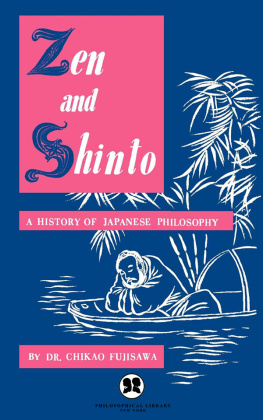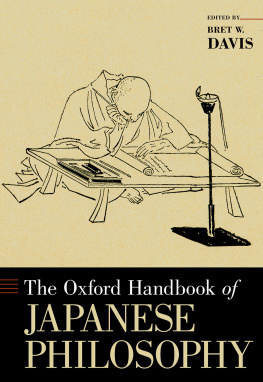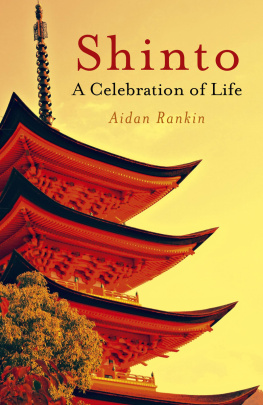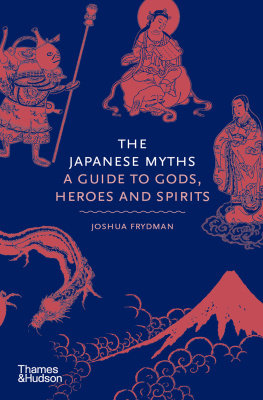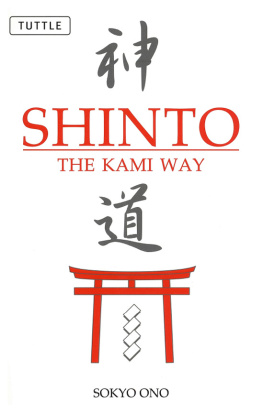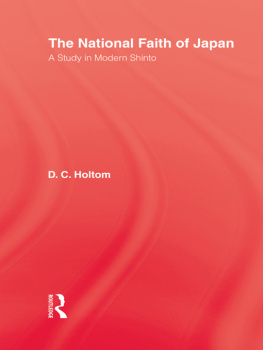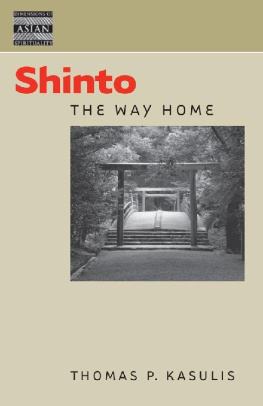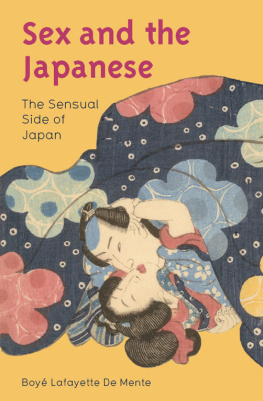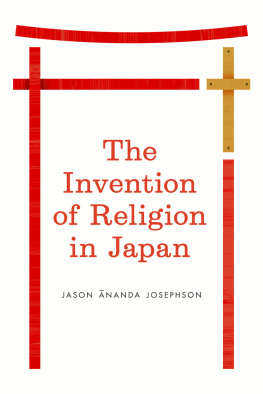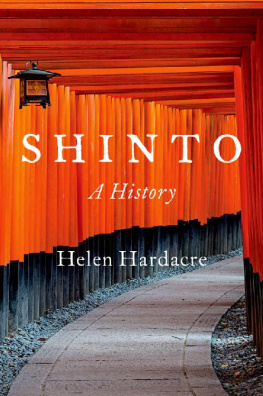THE IMPACT OF SHINTOISM ON THE DEVELOPMENT OF JAPANESE ZEN
Having imbibed the fundamental messages of Taoism and Confucianism, both concerned with the exaltation of Tao, Mahayana Buddhism was brought over to Japan in 552 from China by way of Korea. It was the Prince Regent Shotoku Taishi (573-621), who left no stone unturned in attempting to assimilate all the phases of Buddhist metaphysics and arts. At the same time, he was versed in Confucian ethics and the political principles embodied in its basic teachings. Devout Buddhist that he was, the Prince never forgot to render respectful homage to the deities of Shinto indigenous to the Japanese soil, to whom the pedigree of the Imperial Family is thought to be traced back historically. In brief, he pursued assiduously his wise religious policies with a view to unfolding the spiritual potentialities latent in the Way of Kami. Therefore, what he accomplished by introducing Buddhism into Japan on a sweeping scale, was not to extirpate our national faith called Shinto, but to undertake to all intents and purposes its conscious sublimation. The Roman Emperor Constantine ventured to overthrow the very foundations of ancestral folk-beliefs widely embraced by the Western people when he decided to convert to alien Christianism. Conversely, Shotoku Taishi betook himself to the arduous task of Japanizing Mahayana Buddhism by grafting it on the ever-growing stem of Shintoism. Therefore, the Prince is believed to have given expression to his firm convictions as follows:
Shinto is the root and stem and Confucianism the leaves and branches, while Buddhism is the flowers and fruits. Furthermore, he signalized Japan as the land specifically suitable for transplantation of the lofty principles of Mahayana Buddhism, because Shintoist universal relativism antecedently prepared the fertile and productive ground for the swift germination thereof. Our forefathers used to call our country by the name of Sumera Mikuni, which carries the symbolic meaning: The Divine-Transparent-Clarity-Recuperative-Land. Otherwise stated, Japan is an all-integrative country restorative of existentialist clarity, whatever disruptive force may temporarily turn it into the confused state of turbidity. It is significant that our Emperor has unfailingly played this all-harmonizing and all-reconciling role by taking his wise and yet bold initiative in the digestion and assimilation of the substances of alien cultures. For this reason, he has been invariably held in religious veneration under the designation of Sumera Mikoto: the Divine-Transparent-Clarity (Unity)-Recuperative-Prince. One has witnessed a most conspicuous exemplification of the clarifying and unifying function (displayed by the Japanese Emperor) in the accomplishment of the Meiji Imperial Restoration, when Emperor Meiji undertook an exterior modernization of the Japanese State encumbered with the clogging fetters of feudalistic customs. It was for the purpose of coping with the extreme precariousness of the international situation, which the Japanese people had to face willy-nilly at that moment. It is, however, vital to understand that the Great Sovereign proceeded to revitalize the Shinto faith before embarking on his gigantic plan to strengthen and solidify the basis of Japan in modern terms. As a result, Japan was able to steadily follow its progressive and innovating course of Westernization without running the risk of abandoning its distinct cultural individuality nurtured by the unscathed preservation of Shintoism. This phenomenological correlativeness of Sumera Mikoto and Sumera Mikuni exhibits the peculiar uniqueness of Shinto susceptible of tangibly combining objectivity and subjectivity into a dynamic whole. Therefrom arises the Shintoist principle concerning the identity of Land and Emperor.
This state of affairs finds its unequivocal expression in the interesting Shintoist concept of Kokutai or Kuni Gara: The Nation (State)-Body. The term Gara or Kara has the existential connotation of ex or out of, as it presupposes something hidden and invisible appearing in the phenomenal world with no clear-cut distinction between transcendental unity and immanent diversity. In a word, Kokutai proves the magnifying in conception of the human body and a fresh approach to the study of Japanese culture from this psychosomatic point of view scarcely fails to yield a plentiful harvest which has never been thought of by the forerunners of Japanology who subscribed to the Western positivistic method setting aside any subjective factor as scientifically irrelevant and untenable. But we shall not understand what is meant by the inarticulate word Kokutai (the body of state), unless we grow well conversant with the purport of cosmic dialectics animating Japanese mythology which narrates how Japan was brought into being. Kojiki or the Records of Ancient Matters and Nihon Shoki or the Chronicle of Japan, which were respectively compiled in 712 A.D. and in 720 A.D. under the supervision of the Imperial Court, are held to be the authenticated works constitutive of a most reliable source for the study of Shintology. They furnish descriptions of myths, legends, folklore and historical accounts which throw much light on the basic relationships between the Imperial Family, the Japanese people, and the Land of Japan. Both open with a mythical story bearing on the essential aspects of Shinto cosmology. In particular, Kojiki relates how the three Great Spirits (Kami) came into being on the High Plain of Heaven, when Heaven and Earth parted. They were named the Exalted-Heaven-Center-Lord-Deity (Ameno Minaka-mushi no Kami), the Exalted-High-Production-Deity (Takami Musubi no Kami), and the Divine-Production-Deity (Kami Musubi no Kami). They arose singly and then concealed themselves. The next Spirit which sprouted like a reed floating above the oily slime, was similar to a jelly fish. This deity was named the Princely-Spirit-of-the-Handsome-Reed (Umashi Ashikabizi no Kami).
In all, seven generations of Heavenly Deities succeeded each other in single splendour and at last the Male-Inviting-Deity (Izanagi no Mikoto) and the Female-Inviting-Deity (Izanami no Mikoto) appeared corporeally as the ancestors of all things. Thereupon, the Heavenly Deities commanded Izanagi and Izanami to procreate and consolidate the earth and gave them a celestial jewelled spear. So, the Divine Pair standing on the floating bridge of Heaven (presumably the rainbow) thrust down said spear into the brine and stirred with it until the brine began to curdle. When the spear was pulled up, some of the curdling dripped off and made a pile; finally, it became the island of Onokoro (the self-curdling).
The Divine Couple descended onto this island, where they built a Sacred Bower with a high thick pillar at its center. Around this pillar, the Female Deity turned from the right to the left, while the Male Deity turned the same from the left to the right. When they met in this way, she first addressed herself to him: Oh, what a fine and handsome youth you are! Whereupon he courteously responded to her amorous call, saying: How pretty and lovely a maiden you are! When they thus became united in marriage, they begat a misshapen leech which they straightway placed in a reed-boat and sent adrift to the sea. Their next child was the foamy Island of Awaji, which they were reluctant to include in the number of their healthy and robust offspring. So, they had no choice but to go to Heaven for consultation with the Heavenly Gods. By means of divination, the latter found the true cause of their failure to be ascribable to womans having spoken first, thus transgressing the Cosmic Law, for it gives precedence to the male, expansive, and positive principle over the female, contractive, and passive principle. Accordingly, the Divine Couple descended to their dwelling from heaven and turned round the Sacred Pillar again, this time the Male Deity going from the left and the female Deity from the right. When they met, he spoke first and said: How charming and modest you are! Then she answered blushingly: You are really handsome and manly! Thereafter, they gave birth to the main Eight Islands of Japan proper, together with a host of other smaller islands, the mountains, the valleys, the rivers, the trees, the grass, the mists, and the winds. But, all these things procreated by the Divine Pair were overshadowed by the appearance of the Heaven-Shining-Great-Deity or the Sun Goddess, whose lineal descendants became successive Emperors of Japan. There are two versions referring to the birth of the Sun Goddess. Nihon Shoki reads in part: We (Izanagi and Izanami) have produced the Great-Eight-Island-Country with the mountains, rivers, herbs and trees. Why should we not produce someone who shall be lord of the Universe? So, they gave birth to the Sun Goddess. But Kojiki, considered the Bible of Shinto, relates in this connection, that, when the Female Deity begat the Spirit of the Fire, she was burnt to death and this sad event plunged the Male Deity into the vortex of sorrow and agony. He decided to go down to the Nether World to solicit his wife to return to the Sunny Land. In the meantime, he clandestinely looked into the dark chamber where the putrefied body of his dead spouse lay. Enraged at this insult, she commanded the fiendish hags of Hell to seize her treacherous husband. Taking to his heels, he threw down a variety of articles he wore with a view to halting his hideous pursuers. At last he succeeded in reaching the Land of the Sunshine after having blocked up the path through which the ugly females were chasing him. On that occasion his first care was to purify himself by bathing in the sea, as his sojourn in the Dark Bottomland covered his body with stinking filth. When he washed his left eye, the Sun Goddess sprang into existence. On washing his right eye and his nose, the Moon God and the Storm God were respectively produced. The Sun Goddess was instructed to reign supreme in Heaven as the Queen of the Universe, while the Night Realm was assigned to the Moon Deity. As regards the Tempest Deity, he was asked to rule over the oceanic waves and his ferociously wild nature seems to deify the typhoons which assail Japan in autumn. But, before departing, he ascended to Heaven in order to take leave of his sister (the Sun Goddess). He insulted her by breaking down the divisions made between her rice fields and by fouling the sacred hall where she celebrated the festival of first fruits. When he flayed a piebald colt and flung it into the room where she was weaving the garments of the deities, she lost all her patience with her brothers riotous acts and entered the Rock-Cave. Then, the world was plunged in utter darkness. The Eight Hundred Myriad Deities all in consternation held a divine conference at the Dry Bed of the Heavenly River (the Milky Way) with Omikane-no Mikoto, the wisest deity, presiding over its debates. First, all the singing birds were gathered so that they might prolong their cry for heralding the nearness of a dawn. Next, a huge sacred tree called Sakaki was uprooted from the Heavenly Mountain. They hung the beautiful string of Yasaka Jewels, the eight-sided mirror, and blue and white hemp offerings respectively on its upper, middle and lower branches. At this juncture, all the deities recited a divine liturgy (Norito) in chorus. A female deity called Ameno Uzume skillfully performed a mimic dance, while singing to the accompaniment of a sacred orchestra, from which Gagaku or the Ceremonial Court Music developed in later periods. Soon, the air resounded with the cheers and laughter of the Gods; the Sun Goddess unable to restrain her curiosity to learn the cause of this boisterous merriment peeped out of the cave and beheld her own radiant countenance reflected in the mirror. At this moment, the Hand-Strong-Deity rolled away a great stone which closed the entrance of the cave and pulled respectfully the Solar Goddess out of it. Thereafter, another deity surrounded the door of the heavenly grotto with a sacred straw rope called Shimenawa in Japanese. Several of the most important Shinto rituals and festivals owe their origin to this celestial event fraught with metaphysical significance. The collection of singing birds perched on gates facing the Heavenly Cavern led to the erection of Torii (literally meaning bird-rests) which we shall find in front of every Shinto shrine. When we visit the Shinto shrine, we unfailingly lay a twig of the Sakaki tree with evergreen leaves before its altar so as to enter into communion with Kami who is identical with the very source of cosmic vital energy. The mirror and the string of jewels form the Three Divine Treasures together with the sword which the Tempest God offered to the Sun Goddess. They are held to be the insignia of the Imperial Throne. Thus, in Japan, the ancient tradition stands cheek by jowl with modern progress. Finally, it came to pass that the Storm God was expelled from the High Plain of Heaven after heavy pains and penalties. Some time later, when the Sun Goddess commanded her grandchild called Ninigi no Mikoto to descend from heaven down to earth, she bestowed upon him the three sacred treasures referred to. Upon his descent, she blessed and glorified him by uttering the following words: This Reed-Plain-1500-Autumn-Fair-Rice-Ear Land is the region of which my lineal descendants shall be lords. My august grandchild, do proceed thither and govern it. May prosperity attend thy dynasty, and may it endure forever like Heaven and Earth. About this time the Sun Goddess handed him the divine mirror and said as follows: My grandchild, when thou lookest upon this mirror, let it be as if you wert looking on me. Let it be with thee on thy couch and in thy hall, and let it be a holy mirror to thee.


